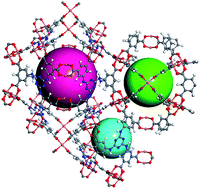CO2 capture in rht metal–organic frameworks: multiscale modeling from molecular simulation to breakthrough prediction†
Abstract
A multiscale modeling study is reported for CO2 capture in a series of metal–organic frameworks (Cu-TDPAT, PCN-61, -66, -68, NOTT-112, NU-111 and NU-110). These MOFs share the same rht topology, though with different ligands. The predicted adsorption isotherms of pure gases (CO2, N2, H2 and CH4) agree well with experimental data. The structure–property relationships between adsorption capacity and ligand size are established. With increasing ligand size, adsorption capacity drops at a low pressure, but increases near saturation conditions. Due to the presence of small ligands, unsaturated metals and amine groups, Cu-TDPAT exhibits the highest adsorption capacity and separation performance among the seven rht-MOFs. On this basis, a new structure, Cu-TDPAT-N, is designed by substituting the phenyl rings in Cu-TDPAT by pyridine rings. Compared to Cu-TDPAT, the N-rich Cu-TDPAT-N possesses higher capacity, isosteric heat and selectivity. From simulated results, the breakthrough profiles for CO2-containing mixtures (CO2/N2, CO2/H2 and CO2/CH4) are predicted, and the breakthrough time for CO2 in Cu-TDPAT-N is found to be extended by two-fold. This study provides microscopic insights into gas adsorption and separation in rht-MOFs, establishes quantitative relationships, and suggests that N-substitution is effective to enhance the performance for CO2 capture.



 Please wait while we load your content...
Please wait while we load your content...